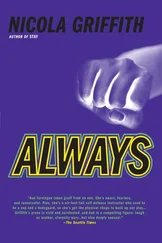The SoHo bar was overlaid with an image of a bar I had gone to many times with Frank. He would hitch his gun belt to a more comfortable position, order a draft and a bowl of pretzels, and expound upon the three kinds of crazy. “There’s your basic loser, some guy whose wife maybe tells him his dick’s too short so he goes on a toot and picks the wrong pansy to beat on. There’s your psychos and sickos—oh, excuse me for breathing, your sociopaths— who are screwed up from crap in their childhoods. That looniness goes way deep, they’re just fucked. And then there’s your As-Ifs, what they call borderline personality disorders, and these guys aren’t human. They look normal, but they don’t feel a goddamn thing, don’t know happy from sad from a hole in the ground. They walk around smiling and frowning and pretending to feel shit, and think everyone else out there is pretending too. No one’s real to these guys, you know what I mean? I don’t mind telling you, Torvingen, they scare the crap out of me.”
Geordie Karp hurt people and manipulated them because they weren’t real to him. He acted as if he were human, but he was a monster.
While I watched, he stood to greet a woman with long hair and long nails whose floor-length leather coat had what looked like solid silver buttons, to match her silver jewelry. It was plain, from the way their bodies asked before touching—a pause, a raised eyebrow, a you-first gesture—that they were almost strangers. What plans did he have for her? Would she let him? It didn’t really matter. She was young and strong and capable of walking away if she didn’t like it, as Tammy should have done. I was more interested in their plans for dinner. They ordered cocktails, then asked for menus. They examined the menus halfheartedly and I thought for a moment they might swallow their drinks and leave, go back to his loft, and get something delivered, but then the woman shrugged, and Karp nodded, and I heard them place their order: salad and entrée, and a bottle of merlot. They would be here at least another hour. I paid and left.
Elevator locks are a more difficult breed to replace than common dead bolts, and Karp had had no reason to bother once Tammy’s key was returned to him. I slid the copied key into the lock and turned. It worked.
On the way up, I unclipped the panel covering the light in the ceiling and looked for a camera. Nothing. When the doors opened I stepped out and sent the elevator back down.
The loft was as I remembered—rich carpet, polished floors, and stark brick support pillars all brilliantly lit, even with no one at home—only now wherever I looked I saw that unfeeling mind at work, controlling, manipulating, hiding.
I started in the most obvious place: the office. Karp’s laptop was out of its leather bag and connected to the printer. I turned it on, but got a password screen. Passwords take time. I could come back to it. The bag held nothing but pens, a notepad, and two cell phone batteries. No interesting papers left in the photocopier. I turned to the stacks of videotapes labeled Gateways Mall, Champaign, IL, cam. #22, 3/27/98 or Courvoisier St., Mobile, AL, cam. #07, 8/19/00 . Ran a few at random. All what they purported to be. No surprise: the one I was after would be hidden somewhere more personal, like the bedroom. Nonetheless, I checked every drawer and cupboard before moving on.
Finding the camera was easy. It was behind the mirror on the wall at the foot of the bed, and hooked up to a sophisticated editing deck. Sophisticated for analog. I checked camera and deck: no tape. I moved on. Nothing in the drawers, or bedside cabinets, or closets. Nothing under the bed or between the mattresses. Nothing between the curtains and the blank, silvered windows. Eyes and souls and windows. Fifteen minutes gone. No tapes or camera in the linen cupboard or medicine cabinet or behind the toilet, nothing in the shower. I would have moved faster but it was not part of my plan for Karp to know anyone had been here. In the living room I peered behind books, lifted paintings from the wall, pulled aside rugs: no cutout boards, no hidden safes. The bronzes were too heavy to move; the mirrors were all one-way glass with nothing lurking beneath. On to the kitchen, where I found nothing in the freezer, or rice and flour bins, or even the garbage. Twenty-five minutes gone, and my heart was pumping easily and my breath coming smooth as cream. I stopped, and straightened, and stood by a support pillar in the center of the huge loft, thinking.
I slid the VCR from its shelf beneath the TV in the living room and traced the cables: no satellite, cable, antenna, or computer connections. I found the electrical box in the hallway by the elevator and flipped the breakers one by one. No circuits running power to any unexplained outlets. Unless he had a camera and recorder running on battery power, there were no more recording devices hooked up. Just the tape, then. Or tapes. It seemed unlikely that there would be only one.
According to Tammy, the loft was his private haven; no casual friends or business associates were ever invited over. So the tapes wouldn’t have to be secure, merely concealed. He probably used them in the same way he used his tapes of shoppers: to study, over and over, and learn from. They would be readily accessible. The hiding place would be obvious, if you knew what to look for.
I closed my eyes and pictured the floor plan, placing the furniture, the lights, the rugs and art, then examined the picture slowly and methodically from every angle. Nothing unusual. I imagined the loft as a whole, its proportions, the roof with its exposed iron girders, its brick-clothed support pillars—and smiled. I laid my hands on the pillar in front of me. Why would he have covered a cast-iron support in brick when he’d left the girders exposed?
I got a ladle from the kitchen and began banging the pillars one by one, and found the hollow one on my third try. I popped open the false front.
There were five shelves. Only the bottom three were filled: a small, matte-black box, a slim sheaf of papers in a file folder, and two rows of tapes. Like his work tapes, these were neatly labeled: Anthony, April, Cody, Fiona… Alphabetical order. No Strange Woman Who Took Tammy Away , no Unidentified Blond Intruder . I found Tammy and took it to the office, where I turned on the video unit, put the tape in, and hesitated.
Have you ever seen yourself having sex? You don’t look human. You are a thing… But I wouldn’t put it past Karp to have one last joke on anyone who found these tapes, and I had to be sure. I pressed PLAY.
If I hadn’t known what to expect, it would have taken me a moment to work out what I was seeing because the body, naked and bound and writhing, and observed close-up, does not move in familiar ways. He must have had remote control on the camera, because the focus zoomed in and out; one minute it was a close-up of a belly and right thigh, slippery with sweat and other things, looking white and enormous and inhuman, the next she was hanging there, about eight feet away. I fast-forwarded until the hanging, writhing figure moved its head and I saw its face. It was Tammy.
My hand shook slightly when I pulled the tape out and put it in my jacket pocket. No one but a lover should ever see such an expression, and then only fleetingly, yet here it was, captured forever.
I went back into the living room. Twenty-two tapes. I carried them eleven at a time into the kitchen. Only six would fit in the microwave at once. I tried the first batch on thirty seconds, picked one at random, Jean— who were you? what dreams of yours did he destroy?—and trotted it through to the office, where I played it. Nothing but a snowstorm. Perfect. Back in the kitchen I did the same for the other three batches, then carried them all to the living room and put them back on the shelves in the right order.
Читать дальше












